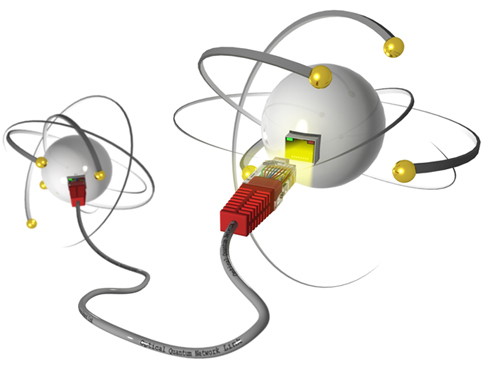A research team at MPQ has devised an initial elementary quantum network, which utilizes interfaces between single atoms and photons.
 Single atoms form the nodes of an elementary quantum network in which quantum information is transmitted via the controlled exchange of single photons. (Graphic by Andreas Neuzner, MPQ)
Single atoms form the nodes of an elementary quantum network in which quantum information is transmitted via the controlled exchange of single photons. (Graphic by Andreas Neuzner, MPQ)
Led by Director of MPQ, Professor Gerhard Rempe, the physicists have developed the first, elementary quantum network, which is made up of two coupled single-atom nodes that send quantum data through the coherent exchange of single photons.
In response to Professor Ignacio Cirac’s proposal, scientists under Professor Rempe worked on systems, wherein single atoms were enclosed in optical cavities having two highly reflecting mirrors positioned at a minimum distance. Atoms emit photons which can be directed to other network nodes. Reflection of photons takes place between the mirrors. The interaction of atoms with photons is powerful, where coherent absorption of photons is carried out by atom.
Using fine-tuned laser beams, quasi-permanent trapping of the atom in the cavity was achieved, followed by emission of single photons carefully from the trapped atom. The scientists demonstrated that the single-atom-cavity system is a characteristic interface for storing the data programmed in a single photon. After a certain storage time, the scientists were able to transfer the data onto a second single photon. Two quantum network systems were deployed in two labs linked through a 60-m long optical fibre and separated by 21 m, where each system served as a network node.
Within a single atom, encoding of quantum information takes place in a coherent superposition of two energy levels. During laser-based photon emission between nodes A and B, transfer of quantum state in atom A onto the atom at node B is carried out. The atomic quantum states were comprehended by mapping onto the polarization of single photons.
In another step, the scientists demonstrated ‘quantum mechanical entanglement’ between the two nodes. Using Einstein’s phenomenon ‘spooky action at a distance’, the scientists made efforts to create entanglement between the two network nodes. Here, the polarization of the single photon by atom A entangled with the atomic quantum state. Following the absorption of photons, transfer of entanglement onto atom B takes place. This is the first time where entanglement was produced between huge particles separated by a large distance.